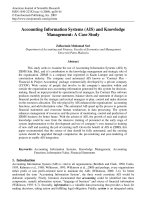Behavioral Finance and Wealth Management ppt
Bạn đang xem bản rút gọn của tài liệu. Xem và tải ngay bản đầy đủ của tài liệu tại đây (1.94 MB, 339 trang )
Behavioral
Finance and
Wealth
Management
How to Build Optimal Portfolios That
Account for Investor Biases
MICHAEL M. POMPIAN
John Wiley & Sons, Inc.
00_POMPIAN_i_xviii 2/7/06 1:58 PM Page iii
00_POMPIAN_i_xviii 2/7/06 1:58 PM Page vi
Behavioral Finance
and Wealth
Management
00_POMPIAN_i_xviii 2/7/06 1:58 PM Page i
Founded in 1807, John Wiley & Sons is the oldest independent publish-
ing company in the United States. With offices in North America,
Europe, Australia, and Asia, Wiley is globally committed to developing
and marketing print and electronic products and services for our cus-
tomers’ professional and personal knowledge and understanding.
The Wiley Finance series contains books written specifically for fi-
nance and investment professionals as well as sophisticated individual in-
vestors and their financial advisors. Book topics range from portfolio
management to e-commerce, risk management, financial engineering,
valuation, and financial instrument analysis, as well as much more.
For a list of available titles, please visit our web site at www.Wiley
Finance.com.
00_POMPIAN_i_xviii 2/7/06 1:58 PM Page ii
Behavioral
Finance and
Wealth
Management
How to Build Optimal Portfolios That
Account for Investor Biases
MICHAEL M. POMPIAN
John Wiley & Sons, Inc.
00_POMPIAN_i_xviii 2/7/06 1:58 PM Page iii
Copyright © 2006 by Michael M. Pompian. All rights reserved.
Published by John Wiley & Sons, Inc., Hoboken, New Jersey.
Published simultaneously in Canada.
No part of this publication may be reproduced, stored in a retrieval system, or
transmitted in any form or by any means, electronic, mechanical, photocopy-
ing, recording, scanning, or otherwise, except as permitted under Section 107
or 108 of the 1976 United States Copyright Act, without either the prior writ-
ten permission of the Publisher, or authorization through payment of the ap-
propriate per-copy fee to the Copyright Clearance Center, Inc., 222 Rosewood
Drive, Danvers, MA 01923, (978) 750-8400, fax (978) 646-8600, or on the
web at www.copyright.com. Requests to the Publisher for permission should be
addressed to the Permissions Department, John Wiley & Sons, Inc., 111 River
Street, Hoboken, NJ 07030, (201) 748-6011, fax (201) 748-6008, or online at
/>Limit of Liability/Disclaimer of Warranty: While the publisher and author have
used their best efforts in preparing this book, they make no representations or
warranties with respect to the accuracy or completeness of the contents of this
book and specifically disclaim any implied warranties of merchantability or fit-
ness for a particular purpose. No warranty may be created or extended by sales
representatives or written sales materials. The advice and strategies contained
herein may not be suitable for your situation. You should consult with a profes-
sional where appropriate. Neither the publisher nor author shall be liable for
any loss of profit or any other commercial damages, including but not limited
to special, incidental, consequential, or other damages.
For general information on our other products and services or for technical
support, please contact our Customer Care Department within the United
States at (800) 762-2974, outside the United States at (317) 572-3993, or fax
(317) 572-4002.
Wiley also publishes its books in a variety of electronic formats. Some content
that appears in print may not be available in electronic books. For more infor-
mation about Wiley products, visit our web site at www.wiley.com.
Library of Congress Cataloging-in-Publication Data:
Pompian, Michael, 1963–
Behavioral finance and wealth management : building optimal portfolios that
account for investor biases / Michael Pompian.
p. cm. — (Wiley finance series)
Includes bibliographical references and index.
ISBN-13 978-0-471-74517-4 (cloth)
ISBN-10 0-471-74517-0 (cloth)
1. Investments—Psychological aspects. 2. Investments—Decision making.
I. Title. II. Series
HG4515.15.P66 2006
332.601'9—dc22 2005027756
Printed in the United States of America.
10 9 8 7 6 5 4 3 2 1
00_POMPIAN_i_xviii 2/7/06 1:58 PM Page iv
This book is dedicated to my wife, Angela. I couldn’t
have done this without her.
00_POMPIAN_i_xviii 2/7/06 1:58 PM Page v
00_POMPIAN_i_xviii 2/7/06 1:58 PM Page vi
Preface ix
Acknowledgments xvii
PART ONE
Introduction to the Practical Application of Behavioral Finance
CHAPTER 1 What Is Behavioral Finance? 3
CHAPTER 2 The History of Behavioral Finance Micro 19
CHAPTER 3 Incorporating Investor Behavior into the Asset
Allocation Process 39
PART TWO
Investor Biases Defined and Illustrated
CHAPTER 4 Overconfidence Bias 51
CHAPTER 5 Representativeness Bias 62
CHAPTER 6 Anchoring and Adjustment Bias 75
CHAPTER 7 Cognitive Dissonance Bias 83
CHAPTER 8 Availability Bias 94
CHAPTER 9 Self-Attribution Bias 104
CHAPTER 10 Illusion of Control Bias 111
CHAPTER 11 Conservatism Bias 119
CHAPTER 12 Ambiguity Aversion Bias 129
CHAPTER 13 Endowment Bias 139
CHAPTER 14 Self-Control Bias 150
CHAPTER 15 Optimism Bias 163
Contents
vii
00_POMPIAN_i_xviii 2/7/06 1:58 PM Page vii
CHAPTER 16 Mental Accounting Bias 171
CHAPTER 17 Confirmation Bias 187
CHAPTER 18 Hindsight Bias 199
CHAPTER 19 Loss Aversion Bias 208
CHAPTER 20 Recency Bias 216
CHAPTER 21 Regret Aversion Bias 227
CHAPTER 22 Framing Bias 237
CHAPTER 23 Status Quo Bias 248
PART THREE
Case Studies
CHAPTER 24 Case Studies 257
PART FOUR
Special Topics in Practical Application of Behavioral Finance
CHAPTER 25 Gender, Personality Type, and Investor Behavior 271
CHAPTER 26 Investor Personality Types 282
CHAPTER 27 Neuroeconomics: The Next Frontier for Explaining
Investor Behavior 295
Notes 303
Index 311
About the Author 318
viii CONTENTS
00_POMPIAN_i_xviii 2/7/06 1:58 PM Page viii
Preface
ix
I
f successful, this book will change your idea about what an optimal in-
vestment portfolio is. It is intended to be a guide both to understanding
irrational investor behavior and to creating individual investors’ portfolios
that account for these irrational behaviors. In this book, an optimal port-
folio lies on the efficient frontier, but it may move up or down that frontier
depending on the individual needs and preferences of each investor. When
applying behavior finance to real-world investment programs, an optimal
portfolio is one with which an investor can comfortably live, so that he or
she has the ability to adhere to his or her investment program, while at the
same time reach long-term financial goals.
Given the run-up in stock prices in the late 1990s and the subsequent
popping of the technology bubble, understanding irrational investor be-
havior is as important as it has ever been. This is true not only for the
markets in general but most especially for individual investors. This book
will be used primarily by financial advisors, but it can also be effectively
used by sophisticated individual investors who wish to become more in-
trospective about their own behaviors and to truly try to understand how
to create a portfolio that works for them. The book is not intended to sit
on the polished mahogany bookcases of successful advisors as a show-
piece: It is a guidebook to be used and implemented in the pursuit of
building better portfolios.
The reality of today’s advisor-investor relationship demands a better
understanding of individual investors’ behavioral biases and an aware-
ness of these biases when structuring investment portfolios. Advisors
need to focus more acutely on why their clients make the decisions they
do and whether behaviors need to be modified or adapted to. If advisors
can successfully accomplish this difficult task, the relationship will be
strengthened considerably, and advisors can enjoy the loyalty of clients
who end the search for a new advisor.
00_POMPIAN_i_xviii 2/7/06 1:58 PM Page ix
In the past 250 years, many schools of economic and social thought
have been developed, some of which have come and gone, while others
are still very relevant today. We will explore some of these ideas to give
some perspective on where behavioral finance is today. In the past 25
years, the interest in behavioral finance as a discipline has not only
emerged but rather exploded onto the scene, with many articles written
by very prestigious authors in prestigious publications. We will review
some of the key people who have shaped the current body of behavioral
finance thinking and review work done by them. And then the intent is
to take the study of behavioral finance to another level: developing a
common understanding (definition) of behavioral biases in terms that
advisors and investors can understand and demonstrating how biases are
to be used in practice through the use of case studies—a “how-to” of be-
havioral finance. We will also explore some of the new frontiers of be-
havioral finance, things not even discussed by today’s advisors that may
be common knowledge in 25 years.
A CHALLENGING ENVIRONMENT
Investment advisors have never had a more challenging environment to
work in. Many advisors thought they had found nirvana in the late
1990s, only to find themselves in quicksand in 2001 and 2002. And in
today’s low-return environment, advisors are continuously peppered
with vexing questions from their clients:
“Why is this fund not up as much as that fund?”
“The market has not done well the past quarter—what should we do?”
“Why is asset allocation so important?”
“Why are we investing in alternative investments?”
“Why aren’t we investing in alternative investments?”
“Why don’t we take the same approach to investing in college money and
retirement money?”
“Why don’t we buy fewer stocks so we can get better returns?”
Advisors need a handbook that can help them deal with the behav-
ioral and emotional sides of investing so that they can help their clients
understand why they have trouble sticking to a long-term program of
investing.
x PREFACE
00_POMPIAN_i_xviii 2/7/06 1:58 PM Page x
WHY THIS BOOK?
This book was conceived only after many hours, weeks, and years of re-
searching, studying, and applying behavioral finance concepts to real-
world investment situations. When I began taking an interest in how
portfolios might be adjusted for behavioral biases back in the late 1990s,
when the technology bubble was in full force, I sought a book like this one
but couldn’t find one. I did not set a goal of writing a book at that time; I
merely took an interest in the subject and began reading. It wasn’t until my
wife, who was going through a job transition, came home one night talk-
ing about the Myers-Briggs personality type test she took that I began to
consider the idea of writing about behavioral finance. My thought process
at the time was relatively simple: Doesn’t it make sense that people of dif-
fering personality types would want to invest differently? I couldn’t find
any literature on this topic. So, with the help of a colleague on the private
wealth committee at NYSSA (the New York Society of Securities Analysts
—the local CFA chapter), John Longo, Ph.D., I began my quest to write on
the practical application of behavioral finance. Our paper, entitled “A New
Paradigm for Practical Application of Behavioral Finance: Correlating
Personality Type and Gender with Established Behavioral Biases,” was ul-
timately published in the Journal of Wealth Management in the fall of
2003 and, at the time, was one of the most popular articles in that issue.
Several articles later, I am now writing this book. I am a practitioner at the
forefront of the practical application of behavioral finance.
As a wealth manager, I have found the value of understanding the be-
havioral biases of clients and have discovered some ways to adjust in-
vestment programs for these biases. You will learn about these methods.
By writing this book, I hope to spread the knowledge that I have devel-
oped and accumulated so that other advisors and clients can benefit from
these insights. Up until now, there has not been a book available that has
served as a guide for the advisor or sophisticated investor to create port-
folios that account for biased investor behavior. My fervent hope is that
this book changes that.
WHO SHOULD USE THIS BOOK?
The book was originally intended as a handbook for wealth management
practitioners who help clients create and manage investment portfolios.
Preface xi
00_POMPIAN_i_xviii 2/7/06 1:58 PM Page xi
As the book evolved, it became clear that individual investors could also
greatly benefit from it. The following are the target audience for the
book:
■ Traditional Wire-house Financial Advisors. A substantial portion of
the wealth in the United States and abroad is in the very capable
hands of traditional wire-house financial advisors. From a historical
perspective, these advisors have not traditionally been held to a fidu-
ciary standard, as the client relationship was based primarily on fi-
nancial planning being “incidental” to the brokerage of investments.
In today’s modern era, many believe that this will have to change, as
“wealth management,” “investment advice,” and brokerage will
merge to become one. And the change is indeed taking place within
these hallowed organizations. Thus, it is crucial that financial advi-
sors develop stronger relationships with their clients because advisors
will be held to a higher standard of responsibility. Applying behav-
ioral finance will be a critical step in this process as the financial serv-
ices industry continues to evolve.
■ Private Bank Advisors and Portfolio Managers. Private banks, such
at U.S. Trust, Bessemer Trust, and the like, have always taken a very
solemn, straightlaced approach to client portfolios. Stocks, bonds,
and cash were really it for hundreds of years. Lately, many of these
banks have added such nontraditional offerings as venture capital,
hedge funds, and others to their lineup of investment product offer-
ings. However, many clients, including many extremely wealthy
clients, still have the big three—stocks, bonds, and cash—for better
or worse. Private banks would be well served to begin to adopt a
more progressive approach to serving clients. Bank clients tend to be
conservative, but they also tend to be trusting and hands-off clients.
This client base represents a vast frontier to which behavioral finance
could be applied because these clients either do not recognize that
they do not have an appropriate portfolio or tend to recognize only
too late that they should have been more or less aggressive with their
portfolios. Private banks have developed a great trust with their
clients and should leverage this trust to include behavioral finance in
these relationships.
■ Independent Financial Advisors. Independent registered representa-
tives (wealth managers who are Series 7 registered but who are not
xii PREFACE
00_POMPIAN_i_xviii 2/7/06 1:58 PM Page xii
affiliated with major stock brokerage firms) have a unique opportu-
nity to apply behavioral finance to their clients. They are typically
not part of a vast firm and may have fewer restrictions than their
wire-house brethren. These advisors, although subject to regulatory
scrutiny, can for the most part create their own ways of serving
clients; and with many seeing that great success is growing their busi-
ness, they can deepen and broaden these relationships by including
behavioral finance.
■ Registered Investment Advisors. Of all potential advisors that could
include behavioral finance as a part of the process of delivering
wealth management services, it is my belief that registered investment
advisors (RIAs) are well positioned to do so. Why? Because RIAs are
typically smaller firms, which have fewer regulations than other ad-
visors. I envision RIAs asking clients, “How do you feel about this
portfolio?” “If we changed your allocation to more aggressive, how
might your behavior change?” Many other types of advisors cannot
and will not ask these types of questions for fear of regulatory or
other matters, such as pricing, investment choices, or others.
■ Consultants and Other Financial Advisors. Consultants to individ-
ual investors, family offices, or other entities that invest for indi-
viduals can also greatly benefit from this book. Understanding how
and why their clients make investment decisions can greatly impact
the investment choices consultants can recommend. When the in-
vestor is happy with his or her allocation and feels good about the
selection of managers from a psychological perspective, the con-
sultant has done his or her job and will likely keep that client for
the long term.
■ Individual Investors. For those individual investors who have the
ability to look introspectively and assess their behavioral biases, this
book is ideal. Many individual investors who choose either to do it
themselves or to rely on a financial advisor only for peripheral ad-
vice often find themselves unable to separate their emotions from
the investment decision-making process. This does not have to be a
permanent condition. By reading this book and delving deep into
their behaviors, individual investors can indeed learn to modify be-
haviors and to create portfolios that help them stick to their long-
term investment programs and, thus, reach their long-term financial
goals.
Preface xiii
00_POMPIAN_i_xviii 2/7/06 1:58 PM Page xiii
WHEN TO USE THIS BOOK?
First and foremost, this book is generally intended for those who want to
apply behavioral finance to the asset allocation process to create better
portfolios for their clients or themselves. This book can be used:
■ When there is an opportunity to create or re-create an asset allocation
from scratch. Advisors know well the pleasure of having only cash to
invest for a client. The lack of such baggage as emotional ties to certain
investments, tax implications, and a host of other issues that accom-
pany an existing allocation is ideal. The time to apply the principles
learned in this book is at the moment that one has the opportunity to
invest only cash or to clean house on an existing portfolio.
■ When a life trauma has taken place. Advisors often encounter a very
emotional client who is faced with a critical investment decision dur-
ing a traumatic time, such as a divorce, a death in the family, or job
loss. These are the times that the advisor can add a significant
amount of value to the client situation by using the concepts learned
in this book.
■ When a concentrated stock position is held. When a client holds a
single stock or other concentrated stock position, emotions typically
run high. In my practice, I find it incredibly difficult to get people off
the dime and to diversify their single-stock holdings. The reasons are
well known: “I know the company, so I feel comfortable holding the
stock,” “I feel disloyal selling the stock,” “My peers will look down
on me if I sell any stock,” “My grandfather owned this stock, so I
will not sell it.” The list goes on and on. This is the exact time to em-
ploy behavioral finance. Advisors must isolate the biases that are
being employed by the client and then work together with the client
to relieve the stress caused by these biases. This book is essential in
these cases.
■ When retirement age is reached. When a client enters the retirement
phase, behavioral finance becomes critically important. This is so be-
cause the portfolio structure can mean the difference between living
a comfortable retirement and outliving one’s assets. Retirement is
typically a time of reassessment and reevaluation and is a great op-
portunity for the advisor to strengthen and deepen the relationship to
include behavioral finance.
xiv PREFACE
00_POMPIAN_i_xviii 2/7/06 1:58 PM Page xiv
■ When wealth transfer and legacy are being considered. Many
wealthy clients want to leave a legacy. Is there any more emotional an
issue than this one? Having a frank discussion about what it possible
and what is not possible is difficult and is often fraught with emo-
tional crosscurrents that the advisor would be well advised to stand
clear of. However, by including behavioral finance into the discus-
sion and taking an objective, outside-councilor’s viewpoint, the client
may well be able to draw his or her own conclusion about what di-
rection to take when leaving a legacy.
■ When a trust is being created. Creating a trust is also a time of emo-
tion that may bring psychological biases to the surface. Mental ac-
counting comes to mind. If a client says to himself or herself, “Okay,
I will have this pot of trust money over here to invest, and that pot of
spending money over there to invest,” the client may well miss the
big picture of overall portfolio management. The practical applica-
tion of behavioral finance can be of great assistance at these times.
Naturally, there are many more situations not listed here that can
arise where this book will be helpful.
PLAN OF THE BOOK
Part One of the book is an introduction to the practical application of
behavioral finance. These chapters include an overview of what behav-
ioral finance is at an individual level, a history of behavioral finance, and
an introduction to incorporating investor behavior into the asset alloca-
tion process for private clients. Part Two of the book is a comprehensive
review of some of the most commonly found biases, complete with a gen-
eral description, technical description, practical application, research re-
view, implications for investors, diagnostic, and advice. Part Three of the
book takes the concepts presented in Parts One and Two and pulls them
together in the form of case studies that clearly demonstrate how practi-
tioners and investors use behavioral finance in real-world settings with
real-world investors. Part Four offers a look at some special topics in the
practical application of behavioral finance, with an eye toward the future
of what might lie in store for the next phase of the topic.
Preface xv
00_POMPIAN_i_xviii 2/7/06 1:58 PM Page xv
00_POMPIAN_i_xviii 2/7/06 1:58 PM Page xvi
Acknowledgments
xvii
I
would like to acknowledge all my colleagues, both present and past,
who have contributed to broadening my knowledge not only in the
topic of this book but also in wealth management in general. You know
who you are. In particular, I would like thank my proofreaders Sarah
Rogers and Lin Ruan at Dartmouth College. I would also like to ac-
knowledge all of the behavioral finance academics and professionals who
have granted permission for me to use their brilliant work. Finally, I
would like to thank my parents and extended family for giving me the
support to write this book.
00_POMPIAN_i_xviii 2/7/06 1:58 PM Page xvii
00_POMPIAN_i_xviii 2/7/06 1:58 PM Page xviii
PART
One
Introduction to the
Practical Application of
Behavioral Finance
01_POMPIAN_001_018 2/7/06 1:50 PM Page 1
01_POMPIAN_001_018 2/7/06 1:50 PM Page 2
3
What Is Behavioral Finance?
People in standard finance are rational. People in behavioral
finance are normal.
—Meir Statman, Ph.D., Santa Clara University
T
o those for whom the role of psychology in finance is self-evident,
both as an influence on securities markets fluctuations and as a force
guiding individual investors, it is hard to believe that there is actually a
debate about the relevance of behavioral finance. Yet many academics
and practitioners, residing in the “standard finance” camp, are not con-
vinced that the effects of human emotions and cognitive errors on fi-
nancial decisions merit a unique category of study. Behavioral finance
adherents, however, are 100 percent convinced that an awareness of per-
tinent psychological biases is crucial to finding success in the investment
arena and that such biases warrant rigorous study.
This chapter begins with a review of the prominent researchers in
the field of behavioral finance, all of whom support the notion of a dis-
tinct behavioral finance discipline, and then reviews the key drivers of
the debate between standard finance and behavioral finance. By doing
so, a common understanding can be established regarding what is meant
by behavioral finance, which leads to an understanding of the use of this
term as it applies directly to the practice of wealth management. This
chapter finishes with a summary of the role of behavioral finance in
CHAPTER
1
01_POMPIAN_001_018 2/7/06 1:50 PM Page 3
dealing with private clients and how the practical application of behav-
ioral finance can enhance an advisory relationship.
BEHAVIORAL FINANCE: THE BIG PICTURE
Behavioral finance, commonly defined as the application of psychology
to finance, has become a very hot topic, generating new credence with
the rupture of the tech-stock bubble in March of 2000. While the term
behavioral finance is bandied about in books, magazine articles, and in-
vestment papers, many people lack a firm understanding of the concepts
behind behavioral finance. Additional confusion may arise from a pro-
liferation of topics resembling behavioral finance, at least in name, in-
cluding behavioral science, investor psychology, cognitive psychology,
behavioral economics, experimental economics, and cognitive science.
Furthermore, many investor psychology books that have entered the
market recently refer to various aspects of behavioral finance but fail to
fully define it. This section will try to communicate a more detailed un-
derstanding of behavioral finance. First, we will discuss some of the
popular authors in the field and review the outstanding work they have
done (not an exhaustive list), which will provide a broad overview of the
subject. We will then examine the two primary subtopics in behavioral
finance: Behavioral Finance Micro and Behavioral Finance Macro.
Finally, we will observe the ways in which behavioral finance applies
specifically to wealth management, the focus of this book.
Key Figures in the Field
In the past 10 years, some very thoughtful people have contributed ex-
ceptionally brilliant work to the field of behavioral finance. Some read-
ers may be familiar with the work Irrational Exuberance, by Yale
University professor Robert Shiller, Ph.D. Certainly, the title resonates; it
is a reference to a now-famous admonition by Federal Reserve chairman
Alan Greenspan during his remarks at the Annual Dinner and Francis
Boyer Lecture of the American Enterprise Institute for Public Policy
Research in Washington, D.C., on December 5, 1996. In his speech,
Greenspan acknowledged that the ongoing economic growth spurt had
been accompanied by low inflation, generally an indicator of stability.
“But,” he posed, “how do we know when irrational exuberance has un-
4 INTRODUCTION TO THE PRACTICAL APPLICATION OF BEHAVIORAL FINANCE
01_POMPIAN_001_018 2/7/06 1:50 PM Page 4









